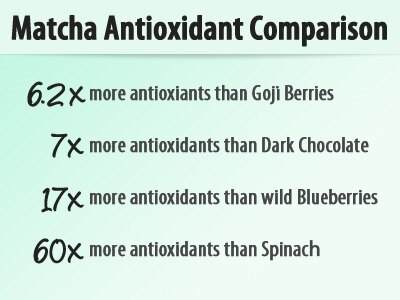Q: What is matcha?
A: Matcha is made from green tea leaves that have been laid out to dry, de-stemmed and ground into an incredibly fine powder. The leaves are picked from shade-grown Camellia sinensis plants. The shade helps slow down the growth of the plant, which allows more time for the production of chlorophyll and amino acids. This is how matcha gets its bright green hue.

Powdered tea was originated in Ancient China; but in 1191, the monk Eisai shared his love and knowledge of powdered tea with Japan. Ever since then, Zen Buddhists have used matcha as an aid during meditation to help improve their focus. Eisai referred to matcha as the “elixir of the immortals.” Powdered tea eventually faded in China and became extremely popular in Japan. But due to primitive methods of production, matcha was only consumed by the nobles and shogun warriors. In the 1700s, production of matcha was revolutionized by Sohen Nagatani and became readily available to the common people of Japan. Today, matcha is quickly becoming popular around the world…and for good reason!
Q: What are the health benefits of matcha?
A: Matcha is an absolute antioxidant powerhouse. The concentration of EGCG (epigallocatechin gallate, the main antioxidant in green tea) is several times greater in matcha versus standard green tea. This is likely due to the fact that the entire leaf is consumed as opposed to tea bags or leaves which are steeped. With an incredible amount of chlorophyll, matcha is often used to help promote internal cleanliness. The mild amount of naturally occurring caffeine in matcha helps to create an energetic and alert state, while the high L-theanine content helps to promote a state of wellbeing and relaxation.* This combination is likely what made matcha a staple for meditation among the Zen Buddhists.
Matcha’s antioxidant profile is unmatched, as you can see in the chart below.
Q: Do I make it like normal tea?
A: There are several ways to consume matcha. For standard tea, stir 1 scoop (approx. 2 grams) of matcha powder into 8 ounces of hot water. Matcha powder is often used to make fancy beverages, like lattes and frozen cappuccinos. It’s also used in food recipes and desserts (green tea ice cream anyone?). Here’s a refreshing blended matcha beverage with homemade whipped “cream” that’s easy, delicious and nutritious:
Matcha Frappuccino
Ingredients
1 cup unsweetened almond milk
2 tbsp. vanilla syrup
1/2 tsp. unsweetened matcha green tea powder
1 cup ice
Pour all ingredients into a blender and blend until smooth. Prepare a vegan whipped topping
Easy Homemade Coco-Whip Topping
1 can coconut milk (full fat variety or it won’t thicken enough)
1 tsp. stevia, or more if want it sweeter
1. Open the can of coconut milk to see if it’s already thick enough. If not, transfer to a bowl, cover and refrigerate for a few hours or overnight.
2. Scoop out only the thick, creamy portion.
3. Using a fork, whip in the stevia until it becomes a fluffy. Spoon the coco-whip on top of your blended matcha, sprinkle with cinnamon and enjoy.
*These statements have not been evaluated by the FDA. These products are not intended to diagnose, treat, cure or prevent any disease.


